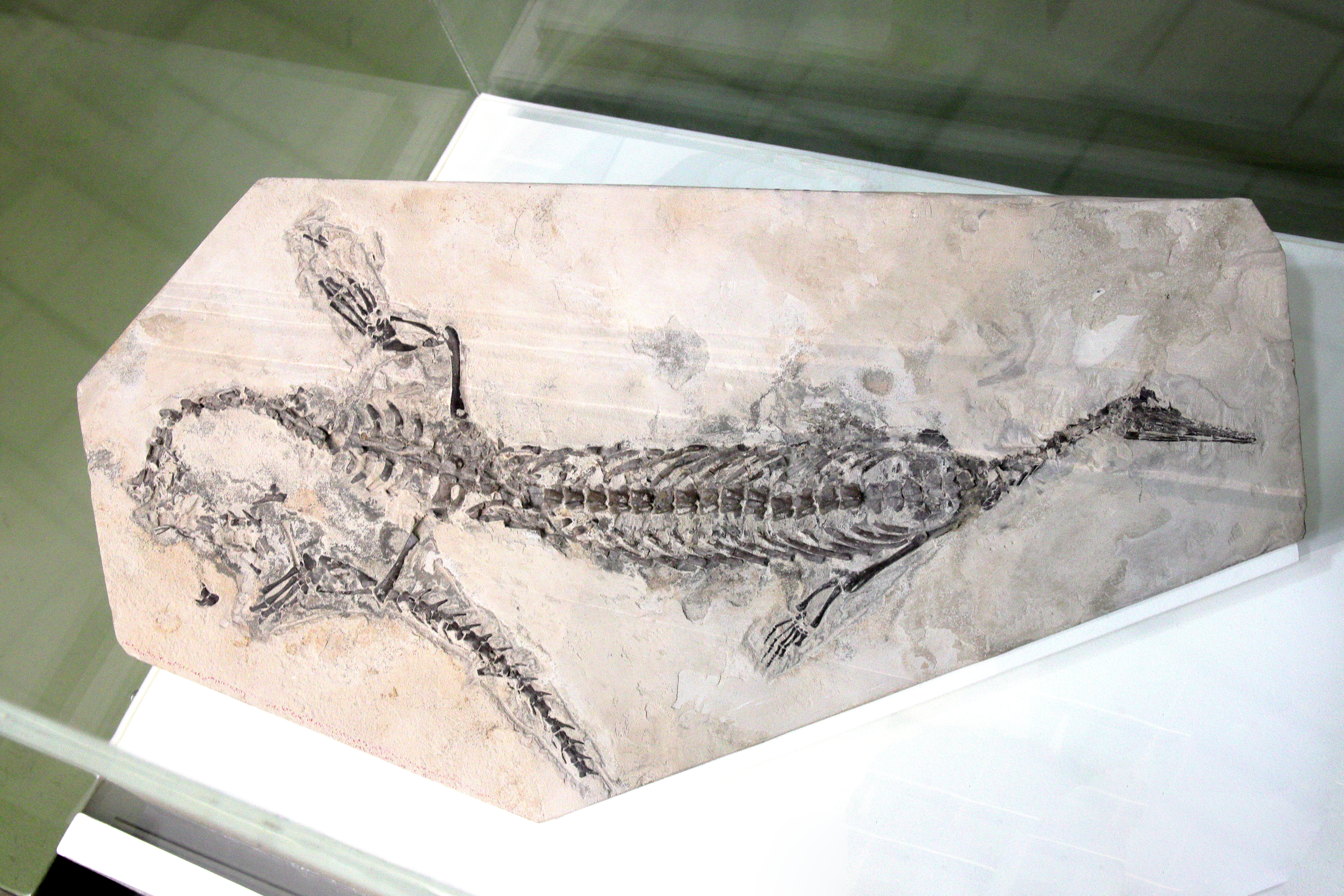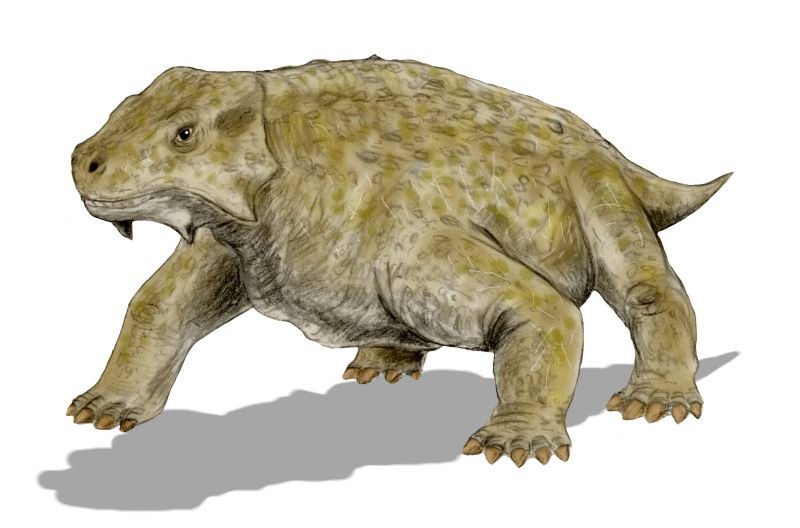|
Parareptilia
Parareptilia ("at the side of reptiles") is a subclass or clade of basal sauropsids ( reptiles), typically considered the sister taxon to Eureptilia (the group that likely contains all living reptiles and birds). Parareptiles first arose near the end of the Carboniferous period and achieved their highest diversity during the Permian period. Several ecological innovations were first accomplished by parareptiles among reptiles. These include the first reptiles to return to marine ecosystems (mesosaurs), the first bipedal reptiles (bolosaurids such as ''Eudibamus''), the first reptiles with advanced hearing systems ( nycteroleterids and others), and the first large herbivorous reptiles (the pareiasaurs). The only parareptiles to survive into the Triassic period were the procolophonoids, a group of small generalists, omnivores, and herbivores. The largest family of procolophonoids, the procolophonids, rediversified in the Triassic, but subsequently declined and became extinct ... [...More Info...] [...Related Items...] OR: [Wikipedia] [Google] [Baidu] |
Mesosaur
Mesosaurs ("middle lizards") were a group of small aquatic reptiles that lived during the early Permian period, roughly 299 to 270 million years ago. Mesosaurs were the first known aquatic reptiles, having apparently returned to an aquatic lifestyle from more terrestrial ancestors. It is uncertain which and how many terrestrial traits these ancestors displayed; recent research cannot establish with confidence if the first amniotes were fully terrestrial, or only amphibious. Most authors consider mesosaurs to have been aquatic, although adult animals may have been amphibious, rather than completely aquatic, as indicated by their moderate skeletal adaptations to a semiaquatic lifestyle.Pablo Nuñez Demarco et al. Was Mesosaurus a Fully Aquatic Reptile? Front. Ecol. Evol, published online July 27, 2018; doi: 10.3389/fevo.2018.00109 Similarly, their affinities are uncertain; they may have been among the most basal sauropsids or among the most basal parareptiles (in the case of w ... [...More Info...] [...Related Items...] OR: [Wikipedia] [Google] [Baidu] |
Sauropsida
Sauropsida ("lizard faces") is a clade of amniotes, broadly equivalent to the class Reptilia. Sauropsida is the sister taxon to Synapsida, the other clade of amniotes which includes mammals as its only modern representatives. Although early synapsids have historically been referred to as "mammal-like reptiles", all synapsids are more closely related to mammals than to any modern reptile. Sauropsids, on the other hand, include all amniotes more closely related to modern reptiles than to mammals. This includes Aves (birds), which are now recognized as a subgroup of archosaurian reptiles despite originally being named as a separate class in Linnaean taxonomy. The base of Sauropsida forks into two main groups of "reptiles": Eureptilia ("true reptiles") and Parareptilia ("next to reptiles"). Eureptilia encompasses all living reptiles (including birds), as well as various extinct groups. Parareptilia is typically considered to be an entirely extinct group, though a few hypotheses ... [...More Info...] [...Related Items...] OR: [Wikipedia] [Google] [Baidu] |
Reptile
Reptiles, as most commonly defined are the animals in the class Reptilia ( ), a paraphyletic grouping comprising all sauropsids except birds. Living reptiles comprise turtles, crocodilians, squamates (lizards and snakes) and rhynchocephalians ( tuatara). As of March 2022, the Reptile Database includes about 11,700 species. In the traditional Linnaean classification system, birds are considered a separate class to reptiles. However, crocodilians are more closely related to birds than they are to other living reptiles, and so modern cladistic classification systems include birds within Reptilia, redefining the term as a clade. Other cladistic definitions abandon the term reptile altogether in favor of the clade Sauropsida, which refers to all amniotes more closely related to modern reptiles than to mammals. The study of the traditional reptile orders, historically combined with that of modern amphibians, is called herpetology. The earliest known proto-reptiles originated ... [...More Info...] [...Related Items...] OR: [Wikipedia] [Google] [Baidu] |
Procolophonomorpha
Procolophonomorpha is an order or clade containing most parareptiles. Many papers have applied various definitions to the name, though most of these definitions have since been considered synonymous with modern parareptile clades such as Ankyramorpha and Procolophonia. The current definition of Procolophonomorpha, as defined by Modesto, Scott, & Reisz (2009), is that of as a stem-based group containing '' Procolophon'' and all taxa more closely related to it than to '' Milleretta''. It constitutes a diverse assemblage that includes a number of lizard-like forms, as well as more diverse types such as the pareiasaurs. Lee 1995, 1996, 1997 argues that turtles evolved from pareiasaurs, but this view is no longer considered likely. Rieppel and deBraga 1996 and deBraga and Rieppel, 1997 argue that turtles evolved from sauropterygians, and there is both molecular and fossil ('' Pappochelys'') evidence for the origin of turtles among diapsid reptiles. Classification The following cl ... [...More Info...] [...Related Items...] OR: [Wikipedia] [Google] [Baidu] |
Pareiasaur
Pareiasaurs (meaning "cheek lizards") are an extinct clade of large, herbivorous parareptiles. Members of the group were armoured with scutes which covered large areas of the body. They first appeared in southern Pangea during the Middle Permian, before becoming globally distributed during the Late Permian. Pareiasaurs were the largest reptiles of the Permian, reaching sizes equivalent to those of contemporary therapsids. Pareiasaurs became extinct at the end of the Permian during the Permian-Triassic extinction event. Description Pareiasaurs ranged in size from long, and may have weighed up to . They were stocky, with short tails, small heads, robust limbs, and broad feet. The cow-sized species '' Bunostegos'', which lived 260 million years ago, is the earliest known example of a tetrapod with a fully erect posture as its legs were positioned directly under its body. Pareiasaurs were protected by bony scutes called osteoderms that were set into the skin. Their heavy skulls ... [...More Info...] [...Related Items...] OR: [Wikipedia] [Google] [Baidu] |
Millerosauria
Millerosauria is an order of Parareptiles that contains the families †Millerettidae and † Eunotosauridae. It is the sister group to the order Procolophonomorpha. It was named in 1957 by Watson. It was once considered a suborder of the disused group Captorhinida and was called Millerosauroidea. All members of this order are thought to be extinct. ''Eunotosaurus ''Eunotosaurus'' (''Latin'': Stout-backed lizard) is an extinct genus of amniote, possibly a close relative of turtles. ''Eunotosaurus'' lived in the late Middle Permian (Capitanian stage) and fossils can be found in the Karoo Supergroup of So ...'' has been recovered as a stem-turtle in recent cladistic studies.Schoch RR, Sues HD (2015) A Middle Triassic stem-turtle and the evolution of the turtle body plan. Nature doi: 10.1038/nature14472. pub ahead of print/ref> References * Parareptiles Prehistoric animal orders Guadalupian first appearances Lopingian extinctions {{permian-reptile-stub ... [...More Info...] [...Related Items...] OR: [Wikipedia] [Google] [Baidu] |
Bolosauridae
Bolosauridae is an extinct family of ankyramorph parareptiles known from the latest Carboniferous (Gzhelian) or earliest Permian (Asselian) to the early Guadalupian epoch (latest Roadian stage) of North America, China, Germany, Russia and France. The bolosaurids were unusual for their time period by being bipedal, the oldest known tetrapods to have been so. Their teeth suggest that they were herbivores. The bolosaurids were a rare group and died out without any known descendants. The following cladogram shows the phylogenetic In biology, phylogenetics (; from Greek φυλή/ φῦλον [] "tribe, clan, race", and wikt:γενετικός, γενετικός [] "origin, source, birth") is the study of the evolutionary history and relationships among or within groups o ... position of the Bolosauridae, from Johannes Müller, Jin-Ling Li and Robert R. Reisz, 2008. References Procolophonomorphs Permian reptiles Paleozoic reptiles of Asia Paleozoic reptiles of Europ ... [...More Info...] [...Related Items...] OR: [Wikipedia] [Google] [Baidu] |
Nyctiphruretid
Nyctiphruretidae is an extinct family of hallucicranian parareptiles known from the late Early to the late Middle Permian of European Russia and south-central United States. Nyctiphruretidae was named by Efremov in 1938. The type genus is '' Nyctiphruretus'' known from several Middle Permian locations in European Russia. Michael S. Y. Lee in 1997 placed the family in the larger clade Nyctiphruretia. The order was defined to include both nyctiphruretids and nycteroleterids. However, recent cladistic analyses suggest that nycteroleterids are more closely related to the Pareiasauria instead, thus making ''Nyctiphruretus'' the only genus of its order. In 2014, MacDougall & Reisz described and named a second genus of Nyctiphruretidae, ''Abyssomedon'', from the middle Leonardian stage of the late Early Permian of Comanche County, Oklahoma, south-central United States. It contains a single species, ''A. williamsi'', which represents the first nyctiphruretid known from North America, ... [...More Info...] [...Related Items...] OR: [Wikipedia] [Google] [Baidu] |
Acleistorhinid
Acleistorhinidae is an extinct Family (biology), family of Late Carboniferous and Early Permian-aged (Moscovian (Carboniferous), Moscovian to Kungurian stage) parareptiles. Acleistorhinids are most diverse from the Richards Spur locality of the Early Permian of Oklahoma. Richards Spur acleistorhinids include ''Acleistorhinus'', ''Colobomycter'', and possibly ''Delorhynchus'' and ''Feeserpeton''. Other taxa include ''Carbonodraco'' from the Late Carboniferous of Ohio and ''Karutia'' from the Early Permian of Brazil. Acleistorhinidae is commonly considered a subgroup of Lanthanosuchoidea, lanthanosuchoids, related to taxa such as ''Chalcosaurus'', ''Lanthaniscus'' and ''Lanthanosuchus''. However, a re-examination of parareptile phylogeny conducted by Cisneros ''et al.'' (2021) argued that lanthanosuchids were not closely related to acleistorhinids. The phylogenetic analysis conducted by these authors recovered acleistorhinids as the sister group of the clade Procolophonia, while lant ... [...More Info...] [...Related Items...] OR: [Wikipedia] [Google] [Baidu] |
Delorhynchus Cifellii
''Delorhynchus'' is an extinct genus of lanthanosuchoid parareptile known from the late Early Permian (Artinskian age) Garber Formation of Comanche County, Oklahoma. It contains three species: the type species ''D. priscus'' is based on a series of maxillae. The second species to be described, ''D. cifellii'', is known from a larger number of well-preserved skulls and skeletal material. The third species, ''D. multidentatus'', is based on a fragmentary skull with several rows of teeth on its jaw. Discovery The type species, ''D. priscus,'' was first described and named by Richard C. Fox in 1962. The generic name "''Delorhynchus''" is derived from Greek ''rhynchos''/''ρυγχος'', meaning "beak" (a common suffix for extinct reptile genera names). The specific name of the type species ''D. priscus'' is derived from Greek ''πρίσκος'', meaning "ancient" or "venerable" in reference to the fragmentary nature of the known remains. ''D. priscus'' is known from the holotyp ... [...More Info...] [...Related Items...] OR: [Wikipedia] [Google] [Baidu] |
Nyctiphruretus Acudens
''Nyctiphruretus'' (meaning "Guardian of the Night") is an extinct genus of nyctiphruretid parareptile known from the Guadalupian series (middle Permian) of European Russia. Many fossils of the type species, ''N. acudens'', were found well preserved near the Mezen River of European Russia in various stages of growth. The dentition identified that ''Nyctiphruretus'' is a herbivore. Based on the large numbers of individuals found and the sediment that they were found in, it appears that their diet consisted of aquatic plants. Adults discovered averaged 36 cm in length with a 4.4 cm skull that was crushed but recognisable. ''Nyctiphruretus'' was first named by Efremov in 1938 and the type species is ''Nyctiphruretus acudens''. In 2002, a second species was named by V. V. Bulanov. ''N. optabilis'' is known from a single jaw, also from Russia, Eastern Europe. Lee (1997) named the order Nyctiphruretia and the family Nyctiphruretidae, to include ''Nyctiphruretus''. While th ... [...More Info...] [...Related Items...] OR: [Wikipedia] [Google] [Baidu] |


.jpg)

